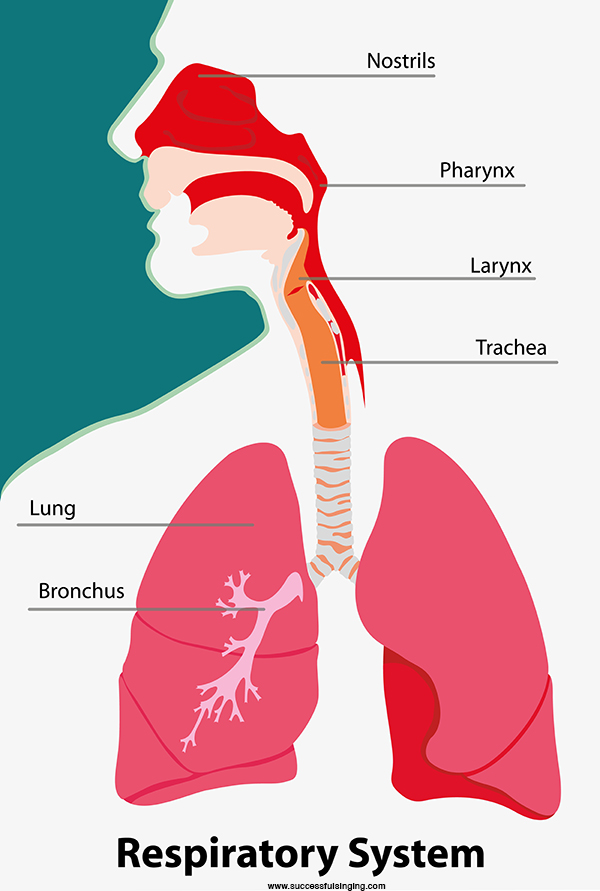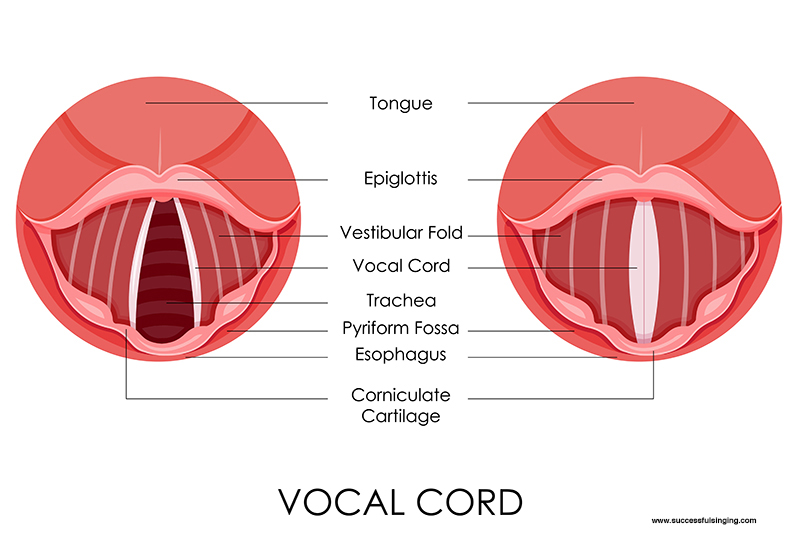About Your Voice
About Your Voice
Your voice is the sound made by vibration of the vocal cords caused by air passing out from your lungs. This vibration creates a sound wave, By controlling the air from your lungs, along with the control of opening and closing your vocal cords are are able to produce a sound. This air naturally needs to exit the body from either your mouth or your nose back out into the atmosphere.
Here again you have control on how you wish to ‘polish’ that sound wave to how you wish it to sound (more on tone and resonance here). You may open your mouth for the sound wave to exit there, or you may divert the soundwave more through your nose as you would if you were to hum.

Respiratory System

Your Respiratory System consists of the nose and mouth, windpipe and lungs. You can find your voice box (known medically as the larynx or more commonly as the Adam’s apple) is situated at the top of your windpipe (trachea).
Find Your Larynx
You can feel your layrnx at the front of your throat. Gently place your hand on throat, about halfway from your chin then swallow. You will feel your larynx move upwards slightly before it returns back to its original position.
As well as housing your vocal cords, your larynx has a protective flap of tissue called your epiglottis which prevents food going into your windpipe as you swallow. As your larynx rises when you swallow, the epiglottis temporarily covers the windpipe for food and liquid to be directed to your gullet. As the larynx relaxes back to its original position, the epiglottis moves back into its own original position (which is below the tongue at the back of the throat) leaving the airway open.
Sometimes this protective mechanism can fail, causing you to cough (or worse choke) as your body to try to expel the foreign object blocking or entering your lungs.
Vocal Cords
The vocal cords (also known as vocal folds) are two bands of stretchy muscle tissue. They are located side by side in the voice box (larynx) just above the windpipe (trachea). These membranes are fixed at one end, giving them a V-shaped and open and close to allow for breathing and sound production.

The cords remain relaxed and open when you breath to create an open passageway to your lungs. As you start to speak or sing, the vocal cords contract (tighten up) and move closer together. Air from the lungs is forced between them and causes them vibrate, producing a sound wave.
The frequency that your vocal cords vibrate will determine the pitch of your sound. They vibrate faster for higher-pitched sounds, slower for lower-pitched sounds.
The tongue, lips, and teeth help form this sound wave into words, or give the sound a more polished sound. More about tone or resonance here.
Your vocal cords are delicate structures. They appear white as there is little blood supply to them. They are also covered in mucous to help prevent them drying out.

Male vocal cords tend to be longer and thicker and vibrate slower within the larynx, giving the male voice a deeper, lower sound. The larynx i(also known as the Adams Apple) tends to be more visible in males because of the length of the cords. Female vocal cords tend to be shorter, thinner and vibrate more quickly, giving the female voice a higher and lighter sound.
Through puberty (usually between the ages of 12 -16), hormonal changes and growth spurts affect your voice. It happens to both boys and girls, however in boys, it is more marked, and is known as their voice breaking. This is because their larynx grow more larger than girls and more quickly. Boys find their voice is unstable around this time as their voice transitions. They may find their voice becomes croaky, they lose the higher end of the notes they used to have, but discover a wonderful lower end to their range. The voice may flip between high and low and can be an embarrassing time for them, but it passes reasonably quickly.
Your Voice
The physical action of singing or speaking is the same for everyone. However, the reason we all sound different to each other is down to our physical attributes. The size and thickness of our vocal cords, the shape of our bone structure, the position of our teeth, our nasal cavity, our sinuses, our tongue.
Once that sound wave is produced by our vocal cords, it travels up towards our mouth and nose, where we resonate that sound wave around our head, shaping and polishing before we exhale our own unique sound.
Your tone and resonance can be improved as you learn to sing. As a singer, learning how to control your breath and using vocal exercises to help you strengthen and develop flexibility in your voice, along with learning how to place notes, polishing the notes in order to make them sound how you want.

